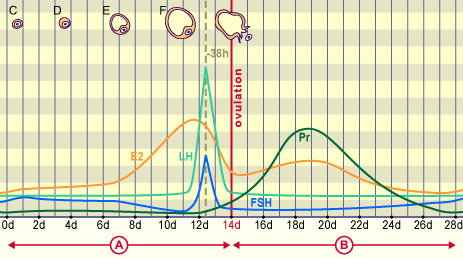|

|
|
|
|
Of the roughly 500'000 follicles that are present in the two ovaries at the beginning of sexual maturity, only around 480 reach the graafian follicle stage and are thus able to release oocytes (ovulation). This number is simply derived by multiplying the number of cycles per year (12) and the number of years in which a woman is fertile (40).
|
|
|
| Ovulation represents an exceptional fate of a follicle. |
|
|
|
|
|
Cyclic changes in the hormone household (hormonal cycle), governed by the hypothalamic-pituitary system, are responsible for the periodicity of the ovulation. In a woman, the rhythmic hormonal influence leads to the following cyclic events:
- the ovarian cycle (follicle maturation) that peaks in the ovulation and the subsequent luteinization of the granulose cells
- cyclic alterations of the endometrium that prepare the uterine mucosa so fertilized oocytes can "nest" there. In the absence of implantation, the mucosa will be eliminated (menstrual bleeding)
|
|
|
|
In the center of this hormonal control is the hypothalamamics-hypophysial (pituitary gland) system with the two hypophysial gonadotropins FSH and LH. The pulsating liberation of GnRH by the hypothalamus is the fundamental precondition for a normal control of the cyclic ovarian function. This cyclic activity releases FSH and LH, both of which stimulate the maturation of the follicles in the ovary and trigger ovulation. During the ovarian cycle, estrogen is produced by the theca interna and follicular cells (in the so-called follicle phase) and progesterone by the corpus luteum (so-called luteal phase).
|
|
|
Definitions
|
|
GnRH:
Gonadotropin- releasing hormone
FSH:
Follicle-stimulating hormone
LH:
Luteinizing hormone
|
|
|
The control circuit of the hormonal cycle has two essential control elements:
- The pulsatile liberation of GnRH, as well as FSH and LH
- The long-loop feedback-effect of estrogen and progesterone on the hypothalamic-hypophysial-system (these two hormones are synthesized in the [ready to rupture] follicle and so originate in the ovary, thus the name "long loop").
|
|
|
|
|
|
As a rule, the ovarian cycle lasts 28 days. It is subdivided into two phases:
- Follicle phase: recruitment of a so-called follicle cohort and, within this, the selection of the mature follicle. This phase ends with ovulation. Estradiol is the steering hormone. Normally, it lasts 14 days, but this can vary considerably!
- Luteal phase: progesteron production by the "yellow body" (= corpus luteum) and lasts 14 days (relatively constant).
|
|
|
More info
|
|
Recruitment of the so-called follicle cohort:
In the recruiting a certain number of primordial follicles are stimulated to mature and to go through the following follicle stages.
(Details)
|
|
|
| Fig. 23 - Course of the hormonal concentrations within the ovarian cycle |
|
Legend |

A
B
C
D
E
F
E2
Pr
LH
FSH |
Follicle phase
Luteal phase
Primary follicle
Secondary follicle
Tertiary follicle
Graafian follicle
Estradiol
Progesterone
Luteinizing hormone
Follicle stimulating hormone |
|
|
|
Fig. 23
The various follicle stages are distributed over the follicle phase. At its end ovulation occurs. Estradiol is the hormone that is formed in the ovary during the follicle phase and progesterone is synthesized in the luteal phase.
|
|
|

